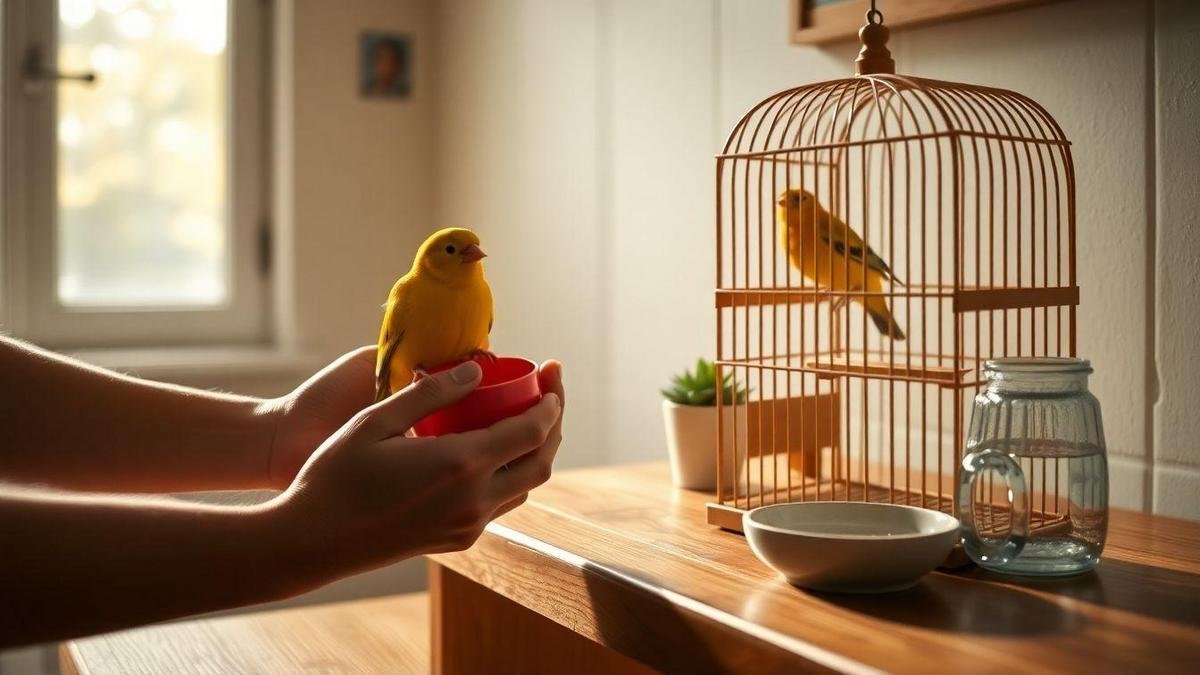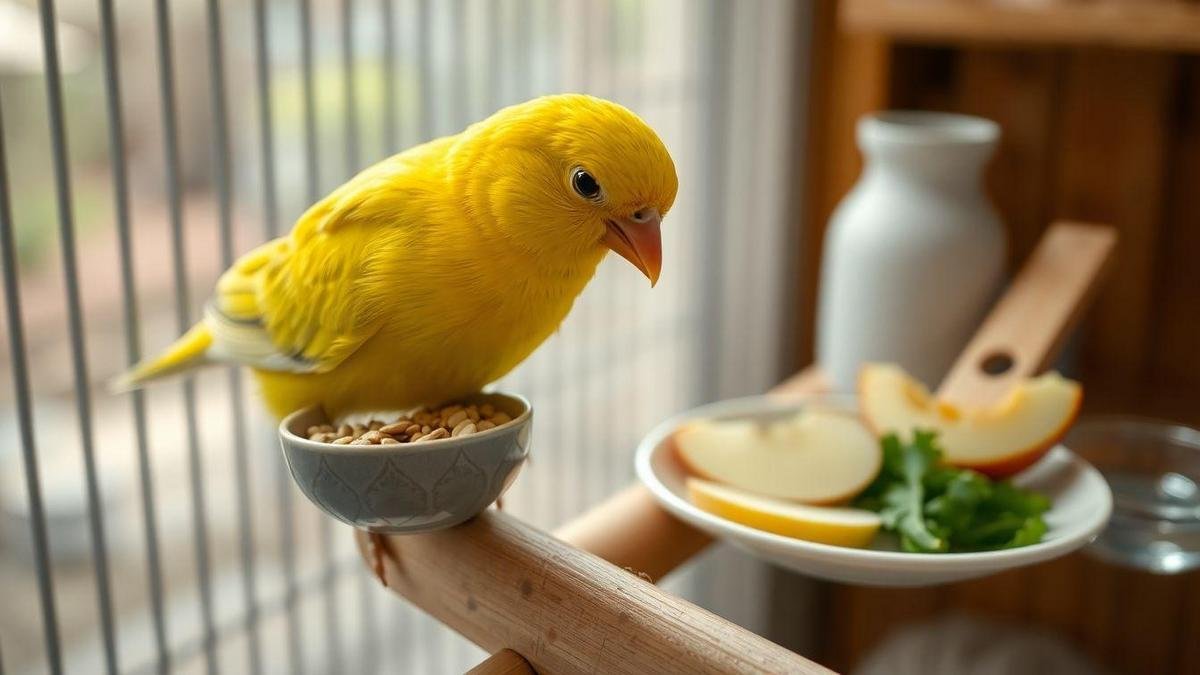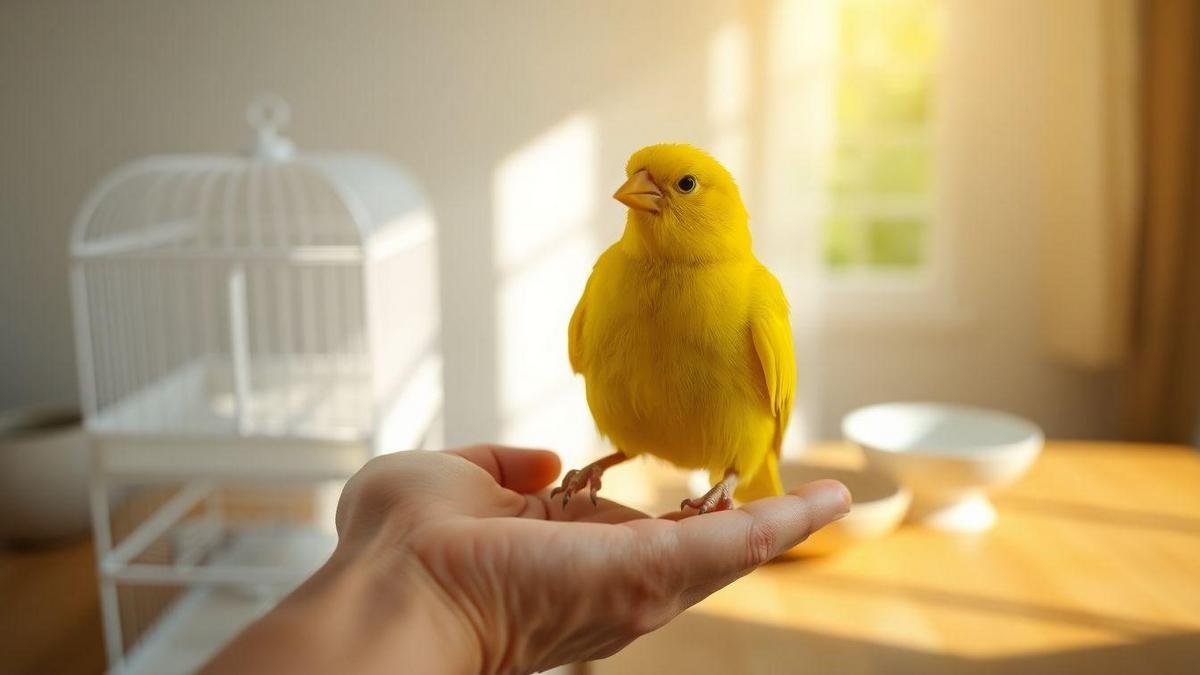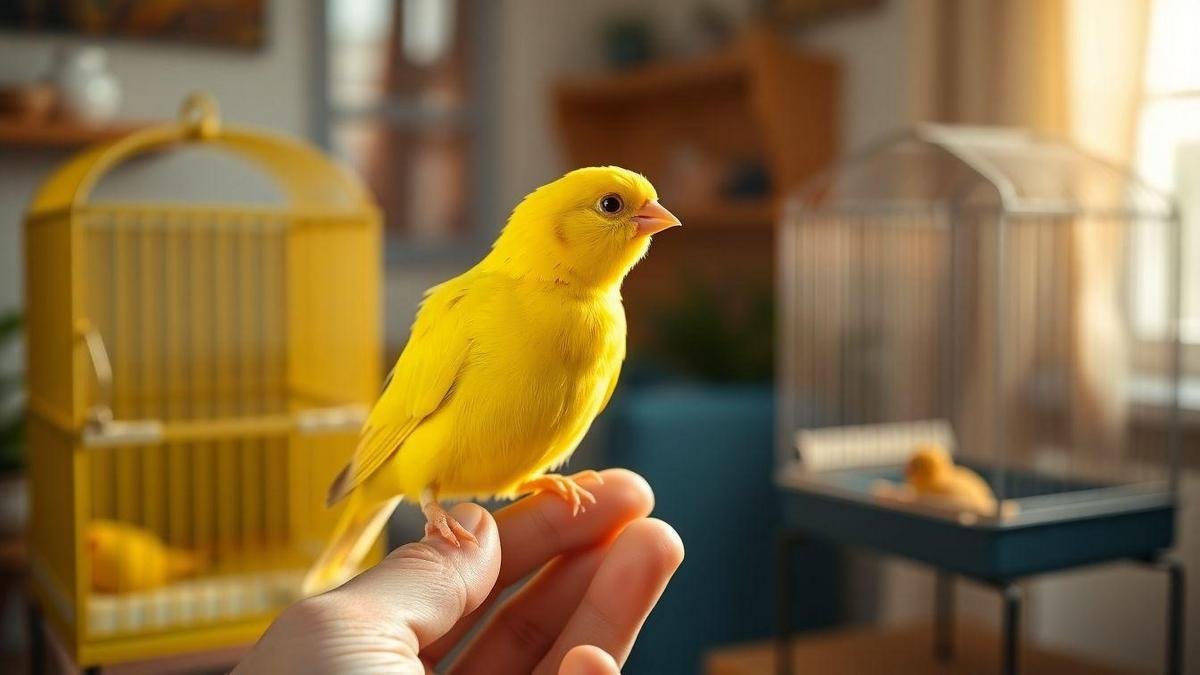Dicas para criação de canários e suas necessidades diárias
I follow a simple morning routine for my canary, similar to building a daily routine for indoor pets: I check food, water, and droppings, give a quick bath or mist, and run a short checklist. I place the cage away from drafts, direct sun, and loud noise, use natural light or a full‑spectrum lamp, and monitor temperature and humidity. I feed a quality seed mix or pellets, rotate fresh greens, add occasional protein when needed, and change food and water daily. I clean trays, perches, toys, and dishes with bird‑safe cleaners, watch for illness, quarantine new birds, and keep my avian vet on call. I train with a calm voice and treats, choose the best cages with proper spacing and room to fly, rotate toys, and allow supervised out‑of‑cage time.
Key takeaway
- Fresh water daily
- Varied seed mix or pellets and fresh greens
- Regular cage and perch cleaning
- Supervised exercise and safe out‑of‑cage time
- Watch for illness and contact an avian vet

Morning routine: simple, fast, effective
I check food, water and droppings every morning
Each morning I quickly check seed levels and any fresh greens, and replace water if cloudy. Clean water keeps a canary active and singing.
I inspect droppings for color and texture. Normal droppings are firm and pale; watery, very dark, or unusual droppings warrant close monitoring and a vet call if they persist.
Short bath or mist for hygiene
I offer a brief bath or gentle mist 2–3 times a week. Use lukewarm water and a fine spray; stop if the bird shows stress. Short baths improve feather health and preening.
Daily checklist (under 5 minutes)
| Task | What I check | Time |
|---|---|---|
| Food | Seed level, fresh greens | 1 min |
| Water | Clear, fresh | 30 sec |
| Droppings | Color, texture | 30 sec |
| Bath/mist | Feather response, calm behavior | 1–2 min |
| Cage | Perches, hazards | 30 sec |
A quick checklist makes issues easier to spot early.

Cage environment: comfort and safety
Placement: avoid drafts, direct sun, and loud noise
Keep the cage where the bird feels safe — think of arranging a pet-friendly indoor space:
- At least 1 meter from open windows/doors
- Away from heavy traffic and kitchen fumes
- No direct midday sun to avoid overheating
I moved my first bird away from a drafty doorway and saw improvement in days.
Light, temperature and humidity
Birds need a clear day‑night rhythm. Aim for about 10–12 hours of light daily; use a full‑spectrum lamp if needed and a timer for consistency. Cover the cage at night for true darkness.
Monitor comfort with a small meter at bird level:
- Temperature: 18–24°C (64–75°F)
- Humidity: 40–60%
Signs of discomfort:
- Fluffed feathers, lethargy = too cold
- Open‑beak breathing = too hot
- Dry skin, brittle feathers = too dry
Fixes: move the cage from vents/heaters, use a humidifier in dry months, and avoid drafts. For colder, darker periods consider tips on helping pets cope with rainy or cold days indoors to keep temperature and light consistent.
Feeding and nutrition

Balanced diet: seed mix or pellets fresh greens
I feed a balanced seed mix and pellets for variety and nutrition. Rotate fresh greens and vegetables (spinach, lettuce, grated carrot) about three times a week. Introduce new foods in small amounts and watch for reactions.
| Food | Benefits | How I serve |
|---|---|---|
| Seed mix | Energy, variety | Small dish daily; remove leftovers after 24h |
| Pellets | Balanced vitamins | Mix with seeds or alone 3–4× weekly |
| Fresh greens | Vitamins A & K | Washed, chopped, 3× week |
| Vegetables | Fiber, minerals | Grated or chopped, small portions |
Protein for molting and breeding
Offer protein (mashed boiled egg or commercial egg food) during breeding or molting—about a teaspoon every other day. Protein supports chicks and feather renewal but avoid overfeeding.
Change food and water daily
Stale food and dirty water breed bacteria. Scrub bowls with hot water and mild soap, rinse well, and replace food immediately if wet or soiled.
Hygiene and cleaning

I follow Dicas para criação de canários e suas necessidades diárias as a daily reminder: keep things simple and consistent.
Tray, perches and deep cleaning
Spot‑clean the tray daily and do a deep clean weekly. Scrub perches and grooves to prevent sticky feet and infections.
| Task | Frequency | Tip |
|---|---|---|
| Tray spot clean | Daily | Scoop droppings, change liner |
| Deep cage clean | Weekly | Warm water, mild soap, rinse |
| Perches scrub | Weekly | Clean grooves where dirt hides |
Toys and bowls
Wash bowls daily and toys weekly using mild dish soap or a vinegar solution; rinse thoroughly and air dry. For guidance on protecting pets during household chores, follow best practices for keeping pets safe during cleaning and chores. Avoid scented cleaners—birds have sensitive respiratory systems.
Bathing options
Offer either a shallow dish (1–2 cm warm water) or a fine mist. Place the dish on the cage floor or perch area and avoid cold drafts. Baths brighten plumage and reduce dust.
Health monitoring and disease prevention

Common signs of illness
Watch daily for:
- Fluffed feathers (cold or illness)
- Lethargy (less movement, quiet)
- Changed droppings (runny, discolored)
| Sign | What I see | What I do |
|---|---|---|
| Fluffed feathers | Bird sits puffed up | Warm cage, monitor 24h, call vet if persists |
| Lethargy | Less movement | Check food/water, reduce stress, vet if no improvement |
| Changed droppings | Runny/discolored | Save sample, isolate if needed, ask vet |
A quick health check every morning acts like a smoke alarm. If you notice behavior or stress signs, resources on how to identify and reduce pet stress indoors and how to set up a relaxation corner for stressed pets can help calm an anxious bird.
Quarantine and vet care
Quarantine new birds for 30 days in a separate room with dedicated tools. Follow your avian vet’s advice on fecal exams and physical checks before introducing new birds to the flock. Guidance on helping a pet settle in can be found in tips to help a pet adjust to a new indoor environment. For overall medical care plans and routine checks, consult a guide to caring for pets and keep your vet’s contact information handy.
Schedule vet checkups every 6–12 months and call immediately for severe signs (labored breathing, blood, sudden collapse). Keep a first‑aid kit and the vet’s number handy.
Training, socialization and cage selection

Socialization: soft voice and treats
Follow Dicas para criação de canários e suas necessidades diárias by spending calm, regular time near the cage. Short sessions (5–10 minutes) with a soft voice and small treats build trust. Stop before the bird becomes tired or stressed. Techniques to help pets feel safe and confident indoors and to encourage positive behavior in indoor pets translate well to canaries.
Choosing the best cage
Select a cage with room to fly a few wingbeats, proper bar spacing, and horizontal perches.
| Feature | Why it matters | Quick tip |
|---|---|---|
| Bar spacing | Prevents head/foot squeeze | ~12 mm (1/2 in) |
| Cage size | Space to stretch and fly | Room for short flights |
| Horizontal perches | Comfort and exercise | Mix perch sizes for foot health |
| Easy cleaning | Disease prevention | Removable trays save time |
Toys and supervised exercise
Rotate toys every few days and consider guidance on introducing new toys and enrichment. Offer supervised out‑of‑cage sessions in a safe room—close windows, disable fans, and limit sessions to 10–20 minutes at first.
Dicas para criação de canários e suas necessidades diárias — practical reminder
The phrase “Dicas para criação de canários e suas necessidades diárias” captures the core of daily canary care: consistency, comfort, clean hygiene, balanced nutrition, and attentive health checks. Use this as a checklist slogan to remember your bird’s daily needs. Repeating the principle “Dicas para criação de canários e suas necessidades diárias” helps keep routines simple and effective. If you ever need to adjust schedules, tips on transitioning pets to a new daily schedule can make the change smoother.
Conclusion
Keep canary care simple and steady: short daily checks of food, water, and droppings, occasional bath or mist, safe cage placement, balanced feeding, regular cleaning, quarantine for new birds, quick vet action when needed, and calm socialization. Consistency is the heart of good care—small habits, big payoff.
If you want more practical tips and real experiences, visit https://blogcraelo.com.
Frequently Asked Questions
Q: How often should I feed my canary each day?
A: I feed twice daily—seeds or pellets in the morning and a small fresh mix at midday. Adjust portions to the bird’s appetite.
Q: What daily checks do I do for health?
A: Look for bright eyes, clean feathers, active movement, and normal droppings. Note any lethargy or changes.
Q: How do I keep the cage clean day‑to‑day?
A: Remove uneaten food, change water daily, spot‑clean droppings, and replace liner when needed.
Q: Should my canary bathe every day?
A: Offer a shallow dish or mist 1–3× weekly. Some canaries enjoy daily baths—follow your bird’s preference.
Q: What top tips summarize Dicas para criação de canários e suas necessidades diárias?
A: Provide fresh water, varied food, safe perches, daily light schedule, quiet time for trust, and prompt vet care when needed.
Q: When should I call the vet?
A: Call immediately for labored breathing, bleeding, sudden collapse, or rapidly worsening symptoms. For gradual changes, monitor 24 hours and contact the vet if no improvement.






